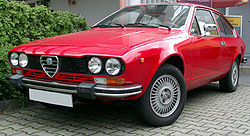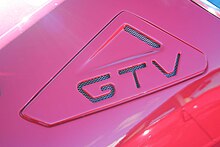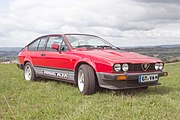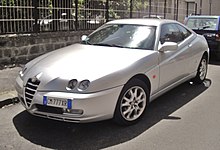Alfa Romeo GTV
| Alfa Romeo GTV | |
|---|---|
| Production period: | 1974-2005 |
| Class : | Sports car |
| Body versions : | Coupé , station wagon coupé |
| Previous model: | Alfa Romeo GT Veloce |
| Successor: | Alfa Romeo Brera |
The Alfa Romeo GTV is a sports coupe from Alfa Romeo . The first generation was based on the Alfa Romeo Alfetta from the beginning of 1974 , the second model was introduced in autumn 1994 together with the new Alfa Romeo Spider after a long break and built until the end of 2005.
Alfetta GT / GTV (1974–1986)
| Alfetta GT / GTV | |
|---|---|
|
Alfa Romeo Alfetta GTV (1974-1980) |
|
| Production period: | 1974-1986 |
| Body versions : | Combi coupe |
| Engines: |
Gasoline engines : 1.6–2.5 liters (76–116 kW) |
| Length: | 4153-4260 mm |
| Width: | 1660-1664 mm |
| Height: | 1330-1334 mm |
| Wheelbase : | 2400 mm |
| Empty weight : | 1000-1210 kg |
The first series of the sports coupé was based on the platform of the Alfetta sedan, which had been shortened by eleven centimeters in the wheelbase and was introduced in early 1974. Its independent body was designed by Giorgio Giugiaro , with whom Alfa Romeo maintained a close collaboration at the time. Giugiaro wanted to realize numerous ideas for the original body design of the Alfetta GT that were unusual for the time.
The combination of an extremely flat and low front with a voluminous rear was intended on the one hand to improve aerodynamics, but on the other hand also offered space for four people and a comparatively ample trunk. The originally planned design of the front with partially covered headlights based on the model of the Alfa Montreal was discarded in the development stage for cost reasons. Due to changed American approval regulations for the height of the headlights, these were enlarged relatively late in the development, which led to the unusual design with the hood pulled down between the light units.
In the further course of development it turned out that numerous other ideas Giugiaro could not be implemented. The originally planned rear design with a sheet metal strongly drawn in between the lights could simply not be produced in this form and had to be changed. The originally planned, new and nowadays common arrangement of the windshield wipers in a gap between the bonnet and windshield was discarded because the developers at Alfa Romeo had concerns about the function in snow in this gap. The open installation of the windshield wipers that was then realized annoyed Giugiaro for a long time. The intended, extremely flat windshield (even flatter than then realized) was made steeper in the course of development because strong optical distortions occurred in the flat windshield and the surface of the dashboard was so intensely reflected that the driver had a very poor view of the front would have. With this change, the lateral curvature of the window was also greatly reduced in order to reduce optical distortions, which in turn led to poorer airflow around the A-pillar and unsatisfactory airflow along the sides of the body. An unusually shaped seal with a flow deflector also had to be installed at the foot of the windshield, because otherwise the windshield wipers would not have had any contact with the windshield even at very low speeds. In wind tunnel tests it also turned out that the design with the tailgate lowered between the roof pillars to guide the air flow with an integrated spoiler was completely pointless, because the flap was no longer exposed to the flow. In addition, small half spoilers had to be installed at the front in order to reduce the strong lift of the front section and to ensure sufficient flow of cooling air. Overall, the aerodynamic quality of the Alfetta GT was comparatively poor, because many ideas turned out to be ineffective. As a result, the body only had a comparatively poor drag coefficient (C w ) of 0.38.
Series models
From the beginning of 1974 to autumn 1980, the coupés were in the versions Alfetta GT (1974-1975), Alfetta GT 1.6 (1976-1980), Alfetta GT 1.8 (1975-1976) and the most powerful version as the Alfetta GTV 2000 (1976-1980 ) built. The output of the 4-cylinder engines was between 79 and 96 kW (108 and 131 hp) depending on the version. A 2-liter turbo version with 110 kW (150 hp) was also available in very small numbers . From 1975 to 1978 right-hand drive models for countries with left-hand traffic were also assembled. Alfa Romeo South Africa also produced a GTV with a 3 liter displacement. This model, which can be recognized from the outside by a large scoop, developed 174 hp, was intended for motorsport and 212 copies were produced from 1984 to 1985.
In the autumn of 1980 the GTV received a fundamental facelift (bumpers, spoilers and side panels made of plastic, new dashboard, new seats, etc.). There were two models: the GTV 6 with the 2.5-liter V-6 engine and 116 kW (158 hp) output (1980–1986) and the GTV 2.0 (1980–1985). The GTV 6 can be recognized externally by a "hump" on the bonnet. The prefix "Alfetta" disappeared from the name.
The GTV has a De-Dion rear axle. The engine is at the front, but the clutch and the gearbox are in a common housing ( transaxle ) with the differential on the rear axle . This gives the vehicle a relatively even weight distribution. The various GTV types are the last rear-wheel drive sports coupes to be mass-produced by Alfa Romeo.
The rear drive train of the Alfetta was always the biggest weak point of these vehicles. On the one hand, the rear gearbox forced a long shift linkage, which, due to poor guidance, led to imprecise handling. On the other hand, the gearbox itself was prone to wear and tear and was not highly resilient. This was shown in sports and performance-enhanced variants, which always revealed problems with the durability of the transmission. That was also the reason why later no larger engines than the 2.5-liter V6 were used - the gearbox simply could not have cope with more torque, and a new gearbox would have been too expensive.
When developing the drive train, Alfa Romeo first had major problems with high-frequency vibrations from the cardan shaft that were transmitted to the transmission. It was only in cooperation with Pirelli that special Giubo clutches could be developed that decoupled the shaft and the transmission from vibration. These flexible coupling elements are a typical wear part of the Alfetta and must be replaced regularly. The high susceptibility to corrosion (until 1983) ensured a short service life despite high used car prices.
When it was produced between the beginning of 1974 and the spring of 1986, the GTV was a familiar sight in its home country, Italy, and it was also sold well in other countries. In addition, there were almost always US versions of the various types.
The Alfetta GT never reached the number of units of its conceptually very similar direct competitor, the Porsche 924 .
The alleged advantages of the Alfetta over the 924 due to the sporty engine, the five-speed gearbox and the complex chassis instead of a modified delivery van engine, a four-speed gearbox and a chassis from a VW parts hodgepodge took a back seat to the disadvantages in handling and practicality in the buyer's view.
Even the interior with four seats and the 'voluminous' trunk were obviously not the criteria according to which customers bought a sports coupé.
The lack of model updates with the poor workmanship, the high susceptibility to corrosion and the poor handling of the transmission, which was always intensely criticized in the press, prevented the sales success of this model series in the long term.
Versions with eight-cylinder engines
Autodelta
Alfa Romeo's motorsport department Autodelta produced some versions of the GT intended for rallying from 1974 , most of which were close to series production. They achieved overall victories in 1975 at the Elba Rally and the Costa Brava Rally.
In 1975 Autodelta then produced two Alfetta GTs, which were equipped with an eight-cylinder boat engine with an output of 257 kW (350 hp). With it, the Alfetta became a direct competitor to the Lancia Stratos . Autodelta reported the vehicle for Amilcare Ballestrieri to the Rallye di Piacenza in autumn 1975. There the Alfetta set the best times, but retired early after the near-series gearbox suffered a defect. At the beginning of 1976, the eight-cylinder Alfetta with Jean-Claude Andruet was used again . Then the project was discontinued because Alfa Romeo was unable to realize the homologation series of 400 copies required by the FIA .
The Reiff Coupé
After the failure of the factory eight-cylinder project, the company Delta Autotechnik in Düren equipped an Alfetta GT with the eight-cylinder engine of the Alfa Romeo Montreal on behalf of the Aachen-based Alfa dealer Reiff . The engine developed 147 kW (200 hp), the top speed was 230 km / h, and 100 km / h was reached in 7.5 seconds. Reiff presented the eight-cylinder coupe publicly at the IAA 1977 in Frankfurt. The purchase price was given as 50,000 DM, later it was reduced to 40,000 DM. Reiff planned a series of 100 copies. However, it did not materialize. In addition to the high selling price, the main reasons for this were technical difficulties, as the standard drive technology was not up to the high performance of the motor. In addition, the production of Montreal engines ended in 1977. Today it is believed that no more than three Reiff coupés were made, only one of which still exists.
particularities
The Alfa Romeo GTV is now a sought-after young and old-timer and is considered by its fans to be one of the last sports coupes of the old school. These vehicles were characterized by their peculiarities, which today would be classified as quality defects and which would make a vehicle unsaleable today.
The Alfetta GT or GTV in the 4-cylinder versions had a corresponding performance due to its two double carburettors, but the cold start presented certain difficulties for an inexperienced driver. If the engine was started successfully, the inexperienced person came out at the latest when engaging first gear, which could not be engaged directly without gear noise from the rapidly wearing gear when the vehicle was stationary. For the experienced "Alfista" it was a matter of course to first move the gear stick slightly in the direction of the second gear after pressing the clutch when the engine was running and then, while still pedaling, to push the gear lever into the first.
Zagato Zeta 6
Based on the Alfetta GTV6, the Milan-based body manufacturer Zagato developed the Zagato Zeta 6, a two-door notchback coupé with a pronounced rounded body, in the early 1980s. The vehicle designed by Giuseppe Mittino was presented to the public at the Geneva Motor Show in March 1983. Series production was initially planned, but did not materialize due to Alfa Romeo's economic difficulties. Zagato made two roadworthy copies of the Zeta 6 that still exist today (2012). A third body shell was built, but the vehicle was not completed.
GTV (1994-2005)
| GTV (916) | |
|---|---|
|
Alfa Romeo GTV (1994-1998) |
|
| Production period: | 1994-2005 |
| Body versions : | Coupe |
| Engines: |
Petrol engines : 1.8–3.2 liters (106–176 kW) |
| Length: | 4285-4299 mm |
| Width: | 1780 mm |
| Height: | 1315 mm |
| Wheelbase : | 2540 mm |
| Empty weight : | 1370-1520 kg |
In March 1994 the new GTV was presented at the Geneva Motor Show. Series production started in September of the same year. The parallel models GTV and Spider, internally referred to as the 916 series, were based on a common platform called Type 2 (Italian Tipo due). It had its origins in the second series of Fiat Tipo and served as the basis for numerous other vehicles from the Fiat group, including the Alfa models 145, 146, 155, 156, 147 and GT. The conceptually very similar Fiat Coupé was also based on this platform, albeit with a different rear axle. In order to further reduce development and production costs, numerous components were taken over from other Fiat group models. The front axle with the extremely direct steering (2.2 turns from lock to lock) was shared by the 916 with the last series of the Alfa 155. In addition, care was taken to assign as many parts as possible identically in both the GTV and the Spider hold on to cut costs. However, in a very late phase of the development project, driving tests with the production-ready vehicle revealed that the driving behavior with a rear axle construction that was identical to that of the Fiat Coupé and was taken directly from Fiat Tipo did not meet the demands of an Alfa Romeo. For this reason, a very complex multi-link axle was developed that was attached to an aluminum carrier, which in turn could be screwed to the body at the same attachment points as the previous rear axle. This aluminum carrier was manufactured in a vacuum casting process, which was revolutionary in vehicle construction at the time and previously only used in aviation. This process was later used in other Alfa Romeo vehicles, for example in the front axle control arms of the 147, 156, 166 and GT models. In addition, the very large engine hood and the fender sections behind the wheel arches were manufactured from Kevlar carbon fiber composite and polyester using an injection molding process called KMC, which combined low tool costs with high rigidity and good manufacturing accuracy. As a result of these elaborate detailed solutions, the targeted sales price of the vehicle became higher and higher, which is why the originally planned interior, designed by Pininfarina, with a painted dashboard similar to the Fiat Coupé, was discarded and redrawn. Many parts of the new interior, however, came from the Fiat Punto, resulting in a quality impression of the interior that did not do justice to the price range and the demands of the vehicles.
Alfa Romeo initially assumed that it would be able to sell more than 20,000 copies of the series annually, which is why production was located in its own factory in Arese and not at Pininfarina, whose production capacities would not have been sufficient. However, the actual numbers sold were significantly below this plan (only around 80,000 vehicles were manufactured in all production years combined), which is why, after a few years of production at Alfa Romeo itself and around 64,000 vehicles, the entire production facilities were relocated to Pininfarina, where then the last 16,000 copies were made.
The transverse engine of the GTV, which was identical to the Spider except for the rear, was available in six versions with a displacement of 1800 to 3200 cm³. The most powerful 3.2 l V6 24V engine with 176 kW (240 PS) accelerates the GTV 916 from 0 to 100 km / h in 6.3 seconds.
The 1.8-liter and 2.0-liter engines were four-cylinder engines from the Fiat modular system with gray cast iron blocks. Only the cylinder heads were made of an aluminum alloy and came from Alfa with the twin-spar technology that had been used for years (2 spark plugs per cylinder). The engine of the 2.0 T.Spark with 16 valves initially developed 110 kW (150 PS), the output of this engine could be increased in 1998 with the conversion of the emission standard from Euro 2 to D3 to 114 kW (155 PS).
At the same time, with the facelift in the early summer of 1998, the 1.8 T. Spark with 144 hp entered the engine range on the German market. This engine, already known as the 2.0 T.Spark from the 145/146 and 155 models, should round off the range at the bottom. However, due to a lack of demand, it disappeared again from the sales brochures in the summer of 2000. At the same time, due to the emissions changeover to Euro 3, the output of the 2.0 T.Spark was reduced again to 110 kW (150 PS).
Above that were the six-cylinder engines, usually referred to as "Arese V6" (after the Alfa production facility). They still had the classic wet cylinder liners for the pistons. They were available as 2.0 liters (12 valves) with turbocharging and 148 kW (202 hp), as 3.0 liters (24 valves) with 160–162 kW (218–220 hp) and, in the last expansion stage, with 3 , 2 liters (24 valves) with 176 kW (240 PS).
In the course of time, some model maintenance measures were carried out. In the summer of 1998, the dashboard was given an aluminum look and the Scudetto a light chrome trim. In 2000, production was relocated from the Alfa Romeo factory in Arese to Pininfarina in Turin.
The models built from spring 2003 can be recognized by the new front. They have been adapted to the current Alfa Romeo appearance and have a chrome grille. On the inside, a lower seating position was made possible by adjusting the seat rails.
Production was discontinued in autumn 2005. The successor was the Alfa Romeo Brera .
Engines
| GTV model | cylinder | Displacement | power | Torque | Top speed | construction time |
|---|---|---|---|---|---|---|
| 1.8 TS | 4th | 1747 cc | 106 kW (144 PS) at 6500 rpm | 169 Nm at 3500 rpm | 205 (215) * | 05.1998-09.2000 |
| 2.0 TS 16V | 4th | 1970 cc | 110 kW (150 PS) at 6300 rpm | 181 Nm at 3800 rpm | 215 (220 *) | 09.1994–05.1998 10.2000–12.2004 |
| 2.0 TS 16V | 4th | 1970 cc | 114 kW (155 PS) at 6200 rpm | 186 Nm at 4000 rpm | 216 (221 *) | 05.1998-09.2000 |
| 2.0 JTS | 4th | 1970 cc | 122 kW (166 hp) at 6400 rpm | 206 Nm at 3250 rpm | 225 | 04.2003-10.2005 |
| 2.0 V6 T B | 6th | 1996 cc | 148 kW (202 hp) at 6000 rpm | 271 Nm at 2400 rpm (with overboost 280 Nm) | 235 (245 *) | 05.1995-09.2001 |
| 3.0 V6 24V | 6th | 2959 cc | 160 kW (218 hp) at 6300 rpm | 265 Nm at 5000 rpm | 250 * | 10.2000-04.2003 |
| 3.0 V6 24V | 6th | 2959 cc | 162 kW (220 PS) at 6300 rpm | 270 Nm at 5000 rpm | 240 | 10.1996-09.2000 |
| 3.2 V6 24V | 6th | 3179 cc | 176 kW (240 hp) at 6200 rpm | 289 Nm at 4800 rpm | 255 | 04.2003-10.2005 |
(*) with aerokit
reliability
The vehicles of the 916 series exhibited some serious deficiencies over their entire construction period, which permanently prevented greater success in the market.
These vehicles were somewhat limited in their practicality, as both versions only had a small trunk, which was insufficiently large after the spare spare wheel was omitted and its replacement by breakdown spray. Both variants had door handles that often made access to the vehicle impossible in cold weather due to icing because the operating buttons froze up. In addition, there was poor processing quality over the entire construction period with poorly fitting interior parts, for example at the transition from the dashboard to the doors, squeaking and rattling noises, water ingress through the frameless door windows and frequent defects in electrical components such as the windscreen wiper motor, the fuel flap release and the electric sliding roof. These shortcomings were always criticized in all test reports and never really eliminated, even if the workmanship of the specimens made by Pininfarina was much better than that of the ones made by Alfa Romeo itself. Alfa Romeo carried out a major recall campaign in 1997 for the vehicles produced up to then, during which many components (windshield wiper motor, shock absorber and handlebars on the rear axle, parts of the exhaust system and much more) were replaced, but these did not eliminate the fundamental defects could. Ultimately, the vehicles of this series were left with their breathtaking styling, their very good roadholding and the ever-praised six-cylinder engines as the only arguments in favor of a purchase.
Especially in direct comparison with the very similar Audi TT, the poor quality and the high susceptibility were particularly noticeable and reliably prevented greater market success. Here the story of the Alfetta GT / GTV was repeated, which in direct comparison with the Porsche 924/944 was also able to record emotional factors as purchase arguments, but revealed enormous weaknesses in practical comparison and in daily use and therefore ultimately failed in the market.
literature
- Alfa Romeo Alfetta Coupé GT / GTV / GTV6 by Umberto Di Paolo / ISBN 978-3-95843-695-4 Heel Verlag 2018
- Stefan Heins: dream wedding . History of the Alfa Romeo GT V8 with a Montreal engine. Oldtimer Markt, issue 4/2010, p. 44 ff.
- Richard Heseltine: Future Shock . Presentation and history of the Zagato Zeta. In: Octane Classic & Performance Cars, issue 4/2012, p. 82 ff.
Web links
Individual evidence
- ↑ Alfa Romeo GTV6 3 liters: la bomb south africaine! , in Boîtier Rouge on April 30, 2015.
- ^ To the whole: Oldtimer Markt, issue 4/2010, p. 44 ff.
- ↑ Octane, issue 4/2012, p. 82 ff.
| Timeline of Alfa Romeo models from 1945 to today | ||||||||||||||||||||||||||||||||||||||||||||||||||||||||||||||||||||||||||||
|---|---|---|---|---|---|---|---|---|---|---|---|---|---|---|---|---|---|---|---|---|---|---|---|---|---|---|---|---|---|---|---|---|---|---|---|---|---|---|---|---|---|---|---|---|---|---|---|---|---|---|---|---|---|---|---|---|---|---|---|---|---|---|---|---|---|---|---|---|---|---|---|---|---|---|---|---|
| Type | Independent until 1933, then state-owned | from 1986 part of Fiat | ||||||||||||||||||||||||||||||||||||||||||||||||||||||||||||||||||||||||||
| 1940s | 1950s | 1960s | 1970s | 1980s | 1990s | 2000s | 2010s | 2020s | ||||||||||||||||||||||||||||||||||||||||||||||||||||||||||||||||||||
| 5 | 6th | 7th | 8th | 9 | 0 | 1 | 2 | 3 | 4th | 5 | 6th | 7th | 8th | 9 | 0 | 1 | 2 | 3 | 4th | 5 | 6th | 7th | 8th | 9 | 0 | 1 | 2 | 3 | 4th | 5 | 6th | 7th | 8th | 9 | 0 | 1 | 2 | 3 | 4th | 5 | 6th | 7th | 8th | 9 | 0 | 1 | 2 | 3 | 4th | 5 | 6th | 7th | 8th | 9 | 0 | 1 | 2 | 3 | 4th | 5 | 6th | 7th | 8th | 9 | 0 | 1 | 2 | 3 | 4th | 5 | 6th | 7th | 8th | 9 | 0 | |
| Small car | MiTo (955) | |||||||||||||||||||||||||||||||||||||||||||||||||||||||||||||||||||||||||||
| Compact class | Arna | |||||||||||||||||||||||||||||||||||||||||||||||||||||||||||||||||||||||||||
| Alfasud | 33 | 145 , 146 (930) | 147 (937) | Giulietta (940) | ||||||||||||||||||||||||||||||||||||||||||||||||||||||||||||||||||||||||
| Middle class | Giulietta Berlina | Giulia | Giulietta (type 116) | 75 | 155 | 156 (932) | 159 (939) | Giulia (952) | ||||||||||||||||||||||||||||||||||||||||||||||||||||||||||||||||||||
| upper middle class | Alfetta | 90 | 164 | 166 (936) | ||||||||||||||||||||||||||||||||||||||||||||||||||||||||||||||||||||||||
| ... | 6C 2500 | 1900 Berlina | 2000 Berlina | 2600 Berlina | 1750/2000 Berlina | Alfa 6 | ||||||||||||||||||||||||||||||||||||||||||||||||||||||||||||||||||||||
| Coupe | Giulietta Sprint | Giulia Sprint GT | Alfasud Sprint | GT (937) | ||||||||||||||||||||||||||||||||||||||||||||||||||||||||||||||||||||||||
| 1900C sprint / super sprint | 2000 sprint | 2600 sprint | 1750/2000 GT Veloce | Alfetta GT / GTV | GTV (916) | Brera (939) | ||||||||||||||||||||||||||||||||||||||||||||||||||||||||||||||||||||||
| Cabriolet | Giulietta Spider | Giulia Spider | Spider ("Duetto") | Spider (916) | Spider (939) | |||||||||||||||||||||||||||||||||||||||||||||||||||||||||||||||||||||||
| 2000 spider | 2600 spider | |||||||||||||||||||||||||||||||||||||||||||||||||||||||||||||||||||||||||||
| Sports car | Disco Volante | Tipo 33 | Montreal | SZ / RZ | 8C Competizione | 4C | ||||||||||||||||||||||||||||||||||||||||||||||||||||||||||||||||||||||
| Off-road vehicle and SUV | Matta | Stelvio (949) | ||||||||||||||||||||||||||||||||||||||||||||||||||||||||||||||||||||||||||
| Vans | Romeo | F12 / A12 | AR6 | |||||||||||||||||||||||||||||||||||||||||||||||||||||||||||||||||||||||||
| AR8 | ||||||||||||||||||||||||||||||||||||||||||||||||||||||||||||||||||||||||||||
|
|
||||||||||||||||||||||||||||||||||||||||||||||||||||||||||||||||||||||||||||









